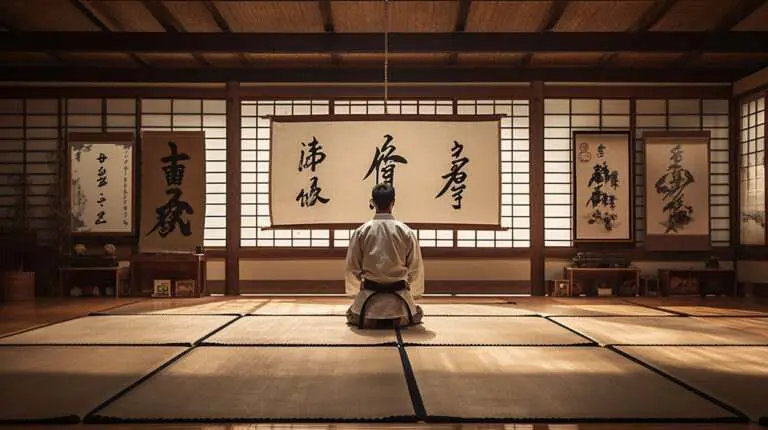Respect and Discipline: Karate Etiquette

Are you ready to step into the world of respect and discipline? Look no further!
In this article, we’ll take you on a journey through the secrets of Karate etiquette. From the proper greetings to respecting the dojo and Sensei, we’ll guide you through the intricate details.
You’ll uncover the significance of phrases like ‘Osu’ and ‘Onegaishimasu’ and learn about the hierarchy within the Karate community.
Get ready to unveil the secrets within Karate’s world of respect and discipline!
The Significance of Greetings and Bowing Etiquette
When interacting with fellow students in Karate, remember to greet them with a bow and say ‘Osu,’ which serves as a sign of respect and hello. Eye contact is essential during greetings and bowing in Karate as it shows sincerity and connection. It demonstrates your focus and acknowledgment of the other person.
Different types of bows are used in Karate, each with its own meaning. The most common bow is called ‘Rei,’ where you stand up straight, heels touching, and bend at the waist about 45 degrees. This bow signifies respect and gratitude.
Another bow used in Karate is the ‘Zarei,’ performed while sitting in the Seiza position. It’s a more profound bow, expressing utmost respect and humility.
The Opening Sequence and Practice Protocol
Follow the opening sequence and practice protocol to set the tone for the session and emphasize respect and discipline.
The opening sequence is a crucial part of Karate practice, and it starts with sitting down in the Seiza position. Take a moment to clear your mind through meditation, known as ‘Mokusou.’ This helps improve focus and prepare you mentally for the session.
It’s important to do so quietly and respectfully when entering the dojo. Bow to the front and greet the dojo and fellow practitioners with ‘Osu.’ If you’re late, apologize to your Sensei and ask for permission to join. Show respect by quickly catching up and not disrupting the class.
Remember the importance of punctuality and strive to be on time.
Showing Respect to the Dojo and Sensei
Bow when entering the dojo and greet your Sensei with a sincere ‘Osu’ to show respect. Proper etiquette when addressing Sensei is crucial in maintaining discipline during practice.
Always refer to your Sensei as ‘Sensei’ or ‘Sensei [last name]’ to show respect for their knowledge and experience. Avoid using their first name unless given permission.
When speaking to your Sensei, maintain a respectful tone and listen attentively to their instructions. Avoid interrupting or questioning their authority during class. It’s important to follow their guidance without hesitation or resistance.
Additionally, maintaining discipline during practice is essential. Stay focused and avoid talking or distracting other students. Show respect for the dojo and your Sensei by arriving on time and participating in cleaning rituals.
Karate Student Names and Hierarchy
You can distinguish the different levels of Karate students by their names and hierarchy within the dojo.
Karate students are generally called Karateka.
As they progress in their training, they earn different titles and ranks. The highest rank is the black belt, which signifies mastery and expertise in Karate. Black belt holders continue their training at different levels called Dan. Each Dan level represents a higher level of skill and knowledge.
In addition to the black belt hierarchy, there are other titles within the dojo. Sensei is a master who’s reached the black belt and serves as the instructor. Senpai is a senior instructor who assists the Sensei. Kohai is a term used to signify a junior student who joined the dojo after another student.
Understanding the Karateka titles and the black belt hierarchy helps to identify the different levels of expertise and respect within the Karate community.
Additional Forms of Respect and Importance of Etiquette
Show respect to your Sensei by listening attentively and following their instructions without interruption.
The CURRENT DISCUSSION TOPIC revolves around the importance of proper attire in Karate and the role of discipline in training. Here are five key points to consider:
- Dressing appropriately in Karate shows respect for the art and your Sensei.
- Wearing the correct uniform, called a gi, helps maintain discipline and unity among practitioners.
- Proper attire allows for freedom of movement and helps prevent injuries during training.
- Discipline is crucial in Karate training, fostering focus, self-control, and perseverance.
- Following the rules and etiquette in the dojo instills discipline and respect for oneself and others.
The Role of Etiquette in Building Discipline and Character
Remember that practicing etiquette in Karate, such as bowing and using respectful language, helps build discipline and character. The importance of mindfulness in practicing etiquette can’t be overstated. By being aware of our actions and words, we can cultivate a sense of respect and discipline that extends beyond the dojo.
Etiquette plays a significant role in fostering a positive training environment. When we treat our fellow practitioners and instructors respectfully, we create an atmosphere of mutual support and growth. It sets the tone for the practice, emphasizing the values of respect, discipline, and mental strength.
Moreover, etiquette teaches us critical life skills such as punctuality, gratitude, and attentiveness. By understanding and practicing etiquette, we enhance our karate abilities and develop into well-rounded individuals.
Conclusion
In conclusion, delving into the secrets of respect and discipline in the world of Karate has uncovered a rich tapestry of etiquette.
From the significance of greetings and bowing to the hierarchy within the Karate community, these principles shape the essence of this ancient martial art.
By embracing and practicing Karate etiquette, students develop discipline and character and contribute to the preservation and appreciation of this revered tradition.
So, continue your journey of respect and discipline in Karate, and unlock the true essence of this remarkable martial art.
